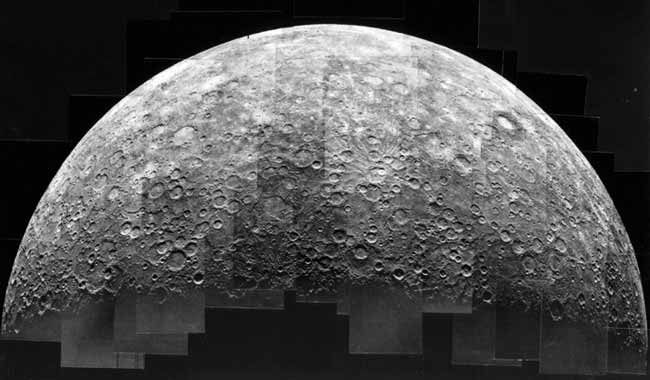
|
Credit: Mariner 10,
NASA
Explanation:
Mercury's surface looks similar to our Moon's.
Each is heavily
cratered and made of rock.
Mercury's diameter is about 4800 km, while the
Moon's is slightly less at about 3500 km
(compared with about 12,700 km for the
Earth).
But
Mercury is unique in many ways.
Mercury is the closest planet to the
Sun,
orbiting at about 1/3 the radius of the
Earth's orbit.
As Mercury slowly rotates, its surface temperature
varies from an unbearably cold -180 degrees
Celsius to an unbearably hot 400 degrees
Celsius.
The place nearest the
Sun in
Mercury's
orbit changes slightly each orbit - a fact used by
Albert Einstein
to help verify the correctness of his then
newly discovered theory of gravity:
General Relativity.
The above picture was taken by the only spacecraft ever to pass
Mercury:
Mariner 10 in 1974.
|
January February March April May June July August September October November December |
| ||||||||||||||||||||||||||||||||||||||||||||||||
NASA Web Site Statements, Warnings, and Disclaimers
NASA Official: Jay Norris. Specific rights apply.
A service of: LHEA at NASA / GSFC
& Michigan Tech. U.
Based on Astronomy Picture
Of the Day
Publications with keywords: Mercury - Solar System
Publications with words: Mercury - Solar System
See also:
- APOD: 2025 September 14 Á Planets of the Solar System: Tilts and Spins
- MESSENGER s Last Day on Mercury
- APOD: 2025 March 31 Á Parker: The Solar System from Near the Sun
- APOD: 2024 September 16 Á Mercurys Vivaldi Crater from BepiColombo
- Solar System Family Portrait
- APOD: 2023 March 26 Á Wanderers
- Planets of the Solar System: Tilts and Spins
